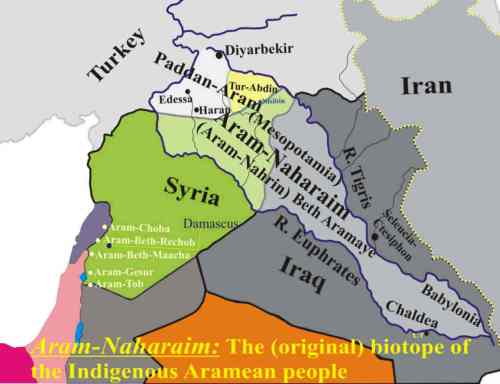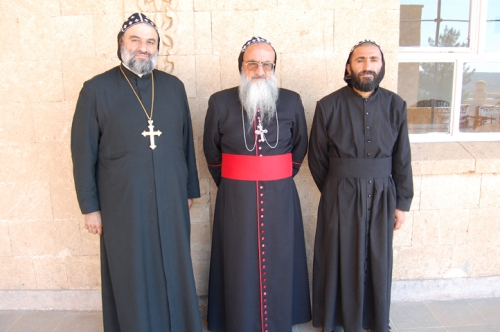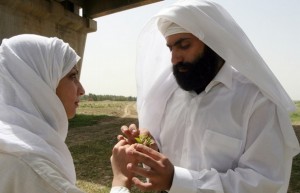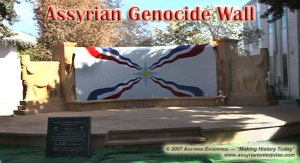Assyrians and Arameans
Bit-Zamani
In 882 BCE, Assurnasirbal II invaded Nairi, which at the time comprised four polities: Bit-Zamani, Shubru, Nirdun, and Urumu/Nirbu. These regions all had their own kings. Bit-Zamani, an ancient Aramean state in northern Mesopotamia, located within the mountainous region of Tur Abdin.
In Bit-Zamani was the city of Amida (Amedu, modern Diyarbakır), an ancient city in Mesopotamia located where modern Diyarbakır, Turkey now stands. The Roman writers Ammianus Marcellinus and Procopius consider it a city of Mesopotamia. The city was located on the right bank of the Tigris. The walls are lofty and substantial, and constructed of the recycled stones from older buildings.
Amid(a), also known by various names throughout its long history, was established as an Aramean settlement, circa the 3rd millennium BC, later as the capital of Bit-Zamani. The oldest artefact from Amida is the famous stele of king Naram-Sin also believed to be from third millennia BC. The name Amida first appears in the writings of Assyrian King Adad-nirari I (C. 1310 -1281 BC) who ruled the city as a part of the Assyrian homeland.
Amida remained an important region of the Assyrian homeland throughout the reign of king Tiglath-Pileser I (1114–1076 BC) and the name Amida appeared in the annals of Assyrian rulers until 705 BC, and also appears in the archives of Armenian king Tiridates II in 305 AD, and the Roman historian Ammianus Marcellinus (325–391 AD).
Bit-Zamani was one of the four Aramean states that bordered Assyria. The others were Bit-Halupe, Bit Bahiani and Laqe. By the ninth century BC all of them lost to Assyria.
Bit Baḫiani was an independent Aramean city-state kingdom (c. 1200 – 808 BC) with its capital at Guzana (modern day Tell Halaf). There were at least five kings and four governors of Bit Baḫiani before losing its name in usage. In the 10th century BCE, the rulers of the small Aramaean kingdom Bit Bahiani took their seat in Tell Halaf, which was re-founded as Guzana. King Kapara built the so-called hilani, a palace in Neo-Hittite style with a rich decoration of statues and relief orthostats.
In 894 BCE, the Assyrian king Adad-nirari II recorded the site in his archives as a tributary Aramaean[citation needed] city-state. In 808 BCE, the city and its surrounding area was reduced to a province of the Assyrian Empire. The governor’s seat was a palace in the eastern part of the citadel mound. Guzana survived the collapse of the Assyrian Empire and remained inhabited until the Roman-Parthian Period.
Bit-Ḫalupe, an ancient Aramean state in eastern Syria, located within the triangular area formed by the confluence of the Khabur River with the Euphrates River. It was one of the four Aramean states that bordered Assyria. The others were Bit-Zamani, Bit Bahiani and Laqe. By the ninth century BC all of them were assimilated by Assyria. In Bit-Ḫalupe was the city of Suru (Al-Suwar). Suru was also among the cities that in 883 BC took part in the unsuccessful rebellion against the Assyrian king Ashurnasirpal II.
The first time Bit-Zamani named was in Assyrian texts from the beginning of the 13th century BC, originating in the city of Shibaniba (modern Tell Billa), in which Ashur-kashid, governor of Bit-Zamani was mentioned. Then Bit-Zamani appears only in Assyrian sources from the beginning of the ninth century BC, from the reign of Assyrian king Tukulti-Ninurta II (890–884 BC).
The king was victorious over Ammi-Ba’al, the king of Bit-Zamani, and then entered into a treaty with him, as a result of which Bit-Zamani became an ally, and in fact a vassal of Assyria. Ammi-Ba’al remained in power, but from that moment on, he had to support Tukulti-Ninurta II during his military expeditions to the Upper Tigris against the Hurrians and Urartians in Nairi.
During the reign of Ashurnasirpal II (883–859 BC), son and successor Tukulti-Ninurta II, Ammi-Ba’al was murdered in 879 BC during a rebellion, which amounted to the throne Bit-Zamani named Bur-Ramman. This was met with the quick reaction from Ashurnasirpal II, who invaded Bit-Zamani, chased rebellion and killed their leader. The Assyrian king appointed Ilan, Bur-Ramman’s brother, on the throne of Bit-Zamani.
At first he remained obedient to the Assyrian king, but later rebelled against him, forcing Ashurnasirpal II to another expedition to Bit-Zamani in 866 BC. He attacked Ilan’s stronghold Damdammusa then the capital Amedu. The result of this expedition is not known, but it appears that Bit-Zamani remained a vassal of Assyria.
In 856 BC, Shalmaneser III (858–824 BC), son and successor of Ashurnasirpal II, during one of his military expeditions, took over Bit-Zamani and annexed the territory of this state to one of the Assyrian provinces (titled Rabshakeh).
Bit-Zamani was later known under different names as province Amedu, Nairi, Sinabu or Tushhan. For example, at the end of the seventh century BC one of Assyrian officials (Limmu), Bel-iqbi mentioned in some of the sources as Governor of Bit-Zamani, while in others as Governor of Tushhan.
Arameere
Assyriere
Mandeere/Sabeere
Yazidi
Folkemord
Kunst av Paul Batou
De ulike samfunn av syriske kristne og talere av ny-arameisk har ulike termer for etnisk selvbetegnelse:
Assyriere, etter det gamle assyriske imperiet, som følger den assyriske kirken i øst & den gamle kirken i øst (østlige assyriere), og andre arameisk-talende kristne fra andre syriske kirker, slik som assyriske nasjonalister fra den syrisk-ortodokse kirken (vestlige assyriere) og den kaldeiske kirken (østlig katolske assyriere).
Arameere eller syriere, etter de gamle arameerne, som følger den syriskort-odokse kirken (arameisk-syriske) og andre arameisk-talende kristne fra andre syriske kirker, slik som noen av de som følger den syrisk-katolske kirken og maronitter-kirken.
Kaldeere, etter det gamle Kaldea, som følger den kaldeisk-katolske kirken (kaldeiske kristne)
Fønikere, etter det gamle Fønikia, som vil si noen maronitter, melkitter og andre syrisk kristne faksjoner i Libanon.
Det assyriske/kaldeiske/syriske folk


Arameere:















Assyriere:











Mandeere/Sabeere:













Yazidi:




















Folkemord:
















Kunst av Paul Batou:









I am not Assyrian nor Chaldean or Akkadian.
I am not a Christian nor Muslim or Buddhist.
I am a human.
I was born in Mesopotamia, Uruk, Nippur, Shuruppak, and Sippar.
I was born in Babylon, home of Anu and Ishtar.
I am a son of Enlil, Shamash, and Gilgamesh.
I am a son of Ishtar, Ea, and Ninsun.
I was killed once by a flood,
And a million times by a creature,
Called Human,
Called a country.
I was killed by a nation,
Or United Nations.
-Identity,


Leave a comment